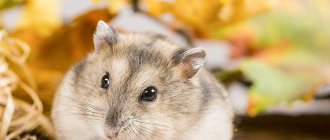Let's start with a couple of lines of encyclopedic information. Do you want to know where your animal comes from and what it is like? And then we’ll immediately talk about caring for Syrian hamsters.
One of the cutest pets.
Syrian hamsters (aka royal, golden, golden) were first mentioned in the 18th century, but a scientific description appeared only in 1836. They were discovered near Aleppo (Syria), which is why they got their name. After this, the rodent was considered extinct for a long time, because The stubborn Syrian hamster did not show itself to the researchers.
The cunning Syrian, foreseeing the future of toys for children and laboratory “consumables” (joke), migrated to the territories of modern Israel, Turkey, Iran, the Balkans, where he still lives safely.
The Syrian hamster hid for almost 100 years, and in 1930, an Israeli zoologist discovered a female with 12 hamsters. Only 4 survived, but this was enough for the rodent to become one of the most popular pets in our time.
What does a Syrian look like and how big will it grow?
Description. The Syrian hamster is a rodent belonging to the hamster family. It has a dense, “strongly built” body - the largest among domestic hamsters. The tail is small and inconspicuous. The predominant color is golden (we’ll talk about types of coats and colors below).
There are rumors that the Syrian hamster has 5 toes on its hind legs and 4 on its front legs. This is not true, there are also 5 on its front legs. It’s just that the thumb is so poorly developed that you can’t even see it.
The average length of an adult royal hamster is 12 cm, the weight of a male is 100-130 g, females - 110-140. But under conditions of good care and nutrition, some eat up to 12 cm in size and weigh 200 g. This is not the result of obesity, just a large animal - it looks almost like a guinea pig.
When choosing a sex, keep in mind that a mature male is more friendly and easier to tame. Female Syrian hamsters often have a bad and aggressive mood.
An adult male with a female in comparison (the female is bicolor).
The character of the hamster and its acquisition
Before choosing a golden animal, pay attention to its behavior. Cute animals are not the same in character, each of them is a personality. If your hamster behaves aggressively, which is not so common, this may be a feature of his character. Ladies are more susceptible to attacks of bad mood. They are slightly larger than males.
As a rule, the Syrian hamster has a good disposition, quickly gets used to people, and willingly communicates with them.
Choose an active animal with a clean coat and no discharge from the nose or eyes. A healthy animal moves vigorously around the cage and does not itch constantly.
Types of fur of the royal rodent
There are 3 main varieties of Syrian hamsters based on their coat type.
Satin . Classic shorthaired Syrians. Often the coat is "glossy", which makes the hamster shine in the light.
Long-haired . A detachment of royal rodents with long hair (individuals with a hairstyle 8-10 cm long are known). Often these Syrian hamsters are also called Angora or Persian. The abundant coat requires special care, so we have dedicated separate material on the website to Angora pets.
And I'm not the shaggiest yet!
Rex. Bred relatively recently, they are covered with thick wavy hair that looks like curls.
Dzungarian breed
Dzungarik is the most common inhabitant of apartments. This is a fluffy, cute pet that is fun to watch. The body shape of the jungarik is slightly different from its counterparts. The spine closer to the tail is slightly curved.
The animal is small in size, as a rule, no more than 10 cm. But the cheeks of the dwarf can grow significantly when “replenishing reserves”. While eating, hamsters are interesting and funny to watch. The size of the pet depends on the characteristics of its maintenance and nutrition. The Djungarian hamster weighs no more than 50 g.
Colors of Syrian hamsters
The original color of the Syrians is golden (reddish-red, sometimes called peach). But now Syrian hamsters have been bred to come in almost any color. List of main colors of Syrian rodents:
- White (sometimes snow white is distinguished separately)
- Beige
- Yellow
- Smoked
- Copper
- Sable
- Black chocolate
- Grey
Classic color.
Cleaning
You can use sawdust, scraps of soft paper, or wood cat litter as bedding. If you choose the latter option, purchase unflavored granules.
Can newspapers be used as bedding for a Syrian hamster? Many people put them under the main filler. This greatly simplifies cleaning, but is very harmful to the health of the animal. Printing ink contains lead, which can cause poisoning.
The Syrian hamster has a specific smell, so it is necessary to regularly clean its cage. Change the filler on a schedule - every 2-3 days. It won't take long, and your house will always smell good.
Caring for a Syrian Hamster
Proper maintenance and care of a royal hamster consists of:
- Have a comfortable home
- Physical activity
- Hygiene
- Good nutrition
- Protection from stress
- Veterinary treatment
What should a pet's house (cage) be like?
Recommendations for house size for the Syrian breed vary greatly, we will try to answer this question as simply as possible. Choose a cage of such a size that maintenance is easy and it can accommodate:
- House for the night
- Toilet
- Utensils for food
- Drinking bowl
- running wheel
Place accessories freely so that the toilet and eating area are as far apart as possible. Additional options in the form of a labyrinth or a second or third level will make the adult pet’s home more comfortable.
What to prefer: a cage, an aquarium, a terrarium or something else? The most suitable option is a cage, and it is easier to care for than other options. An aquarium of sufficient size is also good, but the cage has better air circulation. Good options include a terrarium or a homemade glass shelving unit.
Do not keep your Syrian hamster in a jar or cardboard box. They are too crowded and the small rodent has to sleep in its own excrement. And the lack of “sports equipment” will greatly affect the baby’s health (we will cover this issue a little lower).
Place the house in a quiet place - caring for a Syrian rodent involves the absence of noise. Sudden loud noises will cause him stress and possibly inappropriate behavior. Those. the living room and kitchen are not suitable. The bedroom is also not an option: the hamster is a nocturnal animal and will not let you sleep. One way out is to leave the cage in the bedroom during the day and move it to the living room at night.
Why does a Syrian hamster need to exercise?
In the wild, a hamster runs up to 12 km per night - there is no feeder, and food must be looked for. At home, with proper care, there is plenty of food, it’s not far to run for it. As a consequence - obesity and all the ensuing consequences (problems with the cardiovascular, endocrine systems, musculoskeletal system). Simply put, it will become more difficult for the pet to move, a heart attack is possible, and the likelihood of diabetes increases (although it is much less than in dwarf varieties).
This is why wheels and labyrinths are placed in the cage. You can also use a special walking ball for hamsters.
We strongly do not recommend walking on the street. Open spaces, noise, sunlight will lead to severe stress after the comfort of an apartment. There is also the possibility of picking up parasites somewhere on the lawn or simply losing a nimble little one.
Luxurious apartment with a gym for a rodent.
Hygiene for a healthy hamster
The royal hamster will definitely equip a toilet in the house. You should not try to accustom him to a certain place - it will be easier to care for if you see where he chooses a latrine, and only then install a kennel and a bowl of food as far away as possible.
There should be filler on the floor of the cage, the layer thickness is 2 cm. Typically used:
- Sawdust
- Corn filler
- Granulated
- paper
Experiment for yourself, which is more convenient and fits your budget. Pieces of paper are a cheap care option, but choose ones without fragrances or other additives. Your pet may develop allergies, and in the worst case, poisoning when he tries to eat the bedding. The main thing is not to use cotton wool or other fibrous materials - the baby may simply get entangled and even suffocate.
The filler also requires regular maintenance - change it at least once a week, preferably 2. You can read in detail about how to choose a filler and how they differ in a separate article on the website.
At least once a week, clean the cage and do a wet cleaning. When caring for the house, do not use detergents with a strong smell - the Syrian hamster may refuse to return to the house. Don't forget to take care of your pet's pantry: don't throw everything away, but remove perishable foods.
The correct “ground floor” of the house with bedding.
About bathing a hamster
The Syrian hamster lives in the steppe. He not only doesn’t like water, he hates it!
Do not resort to water procedures unless absolutely necessary. But if you really have to (a quickie gets into something, it happens), read carefully about how to bathe a rodent here.
The Syrian hamster handles hair care itself - with the help of its tongue and paws. If you want to help him care for him, place a container of sand (sold in pet stores). It is with this “bathing” that Syrian pets clean themselves in nature.
Is it possible to bathe
Nature does not provide for hamsters to bathe in water; they take care of themselves by washing their paws and cleaning their fur several times a day.
During the short life of Syrian hamsters, it is unlikely that the owners will need to bathe them in water, but in exceptional cases this can be done. Bathing is carried out very quickly under running warm water using zoo shampoo for rodents, without wetting the head and face. After bathing, the animal should be dried as quickly as possible: blot the fur with water-absorbing material and dry with a hair dryer with a warm stream of air.
Bathing your pet can be fraught with stress, at the very least, and if it becomes hypothermic, it can become seriously ill.
What to feed your Syrian hamster?
The Syrian diet in nature consists of:
- Seeds and cereals (the basis of rodent nutrition)
- Herbs
- Insects
In your home life, also try to adapt to this list.
A mixture of grains and seeds is the main thing you need to give your pet. An excellent option is ready-made dry food for hamsters. If the manufacturer has enriched the composition with vitamins and minerals, even better.
Do not buy food for other rodents and animals. Some substances that are harmless to large pets can poison the baby.
If you prefer to control the composition of the food yourself, and caring for the animal gives you pleasure, here is a simple video instruction for preparing the mixture.
The most common set is oats, millet, corn, and some seeds.
You can also add some nuts to the food (except for almonds and Brazilian almonds - they contain a high concentration of substances dangerous to rodents).
The Syrian hamster will also benefit from greens (lettuce, dill). Eliminate onion and garlic shoots and sorrel from your diet.
In season, add fresh vegetables, fruits and berries to your menu. But this should be done carefully. The Syrian is not as prone to diabetes as the Djungarian, but still avoid overly sweet fruits and starchy vegetables. Use the glycemic index table of foods - very useful information for those who care for the Syrian animal. Try not to give foods that have a GI of more than 50 - an excess of easily digestible carbohydrates.
Don't forget about protein. Buy ready-made dried insects or feed your pet 1-2 times a week with the following products of your choice:
- Egg white
- Boiled chicken breast
- Boiled lean white fish
Lactating and pregnant females, as well as their offspring, need special care and more protein - give protein foods a little daily.
Syrian hamsters' teeth grow throughout their lives. Place a mineral stone or piece of wood in the cage to grind down the fangs.
We talk in detail about what you can and cannot feed your golden hamster in a separate article on the website.
When in season, berries are an excellent addition to your diet.
Reproduction
Syrian hamsters reach sexual maturity at the age of 1-1.5 months, but at this time the growth and development of the body has not yet ended. The first placement of a male with a female is carried out when the pets are 4-6 months old. The duration of pregnancy is approximately 16-19 days, breastfeeding is 3-4 weeks, after this time the children can be separated from their mother.
After giving birth, the hamster should recover within 2-3 months, and only after that can pregnancy be planned again, so about 4 litters occur in 1 year. If this indicator increases, the health of the female may deteriorate, and the offspring will be born weak.
After one year of life, the ligaments of the pelvic bones become inelastic, and the animal loses the ability to give birth. Thus, in her entire life, a hamster is capable of giving birth 3-5 times , but it is worth remembering that Syrian hamsters are prolific and can give birth to 6-12 babies at a time, and sometimes up to 18.
Determining the sex of the hamster
It is almost impossible to determine the sex of the cubs; sexual characteristics become clear at the age of 2 months. If the male is laid on his back, large testicles can be seen.
In general, there are no particular differences in the behavior of the animals, but many owners have noticed that males smell less and make contact with humans more easily than females.
Syrians don't like stress
How to avoid stress?
Why avoid it at all? When a pet is stressed, its behavior changes unpredictably. He may stop eating, may behave aggressively or, conversely, indifferently. Caring for a Syrian under stress becomes very difficult.
We have already listed the main stress factors, let’s summarize them:
- Noise, especially loud
- Daylight
- Water treatments
- Other hamsters and animals
Hamsters are solitary animals; they unite only during mating. Remember this, and do not try to “make friends” of the Syrian with other hamsters and other pets.
It is also worth gradually accustoming the golden handsome man to your hands. The Syrian is the most peaceful type of hamster, but even among them there are quarrelsome characters. There is no point in rushing things and expecting mutual love from the first days.
Read more about taming and other training on our website.
That's how stressed I am... Don't hurt the rodent!
Singles or need neighbors
If you want to buy several hamsters, you need to know that each one will need its own individual cage. While affectionate and funny with their owners, they treat their own kind completely differently. Being territorial animals, these rodents will fight for territory and compete to the last, and if the weaker one has nowhere to go to hide from the wrath of an opponent, he will be killed.
Staying together is possible only for a few minutes during mating, naturally, under the supervision of an adult, responsible person who is able to recognize and react if a romantic date has turned into a fight, and to seat the unsuccessful couple.
If there are many questions about keeping hamsters in the same apartment with predators, then proximity to fish - minorcas, cockerels, guppies, laliuses, astronotuses, platies, barbs, gouramis, veiltails - will not harm anyone.
The rest of the time it is unacceptable to keep hamsters in a common cage.
Syrian Hamster Health
Common health problems in the king hamster:
- Obesity
- Eye diseases
- Gastrointestinal disorders
- Skin diseases
- Injuries
If you notice external signs of illness (inflammation, scratching, diarrhea) or your pet’s behavior has changed (became lethargic, makes strange sounds, does not eat), immediately contact a veterinarian (a specialist in rodents is called a ratologist). Under no circumstances should you treat it yourself, otherwise there may be no one to care for you.
To avoid injury, keep an eye on the animal while walking around your apartment or house. Hamsters live on plains, so they don’t understand what height is. Before you know it, your pet will fall off the back of the sofa and break its leg.
We wrote in detail about the diseases of Syrian hamsters and their care in a separate article.
Don't panic! The doctor knows what to do.
Important Warnings
If your hamster squeaks or hisses, it means he is excited or scared. If this type of behavior occurs, the animal should be left alone.
It is worth protecting your pet from any items containing harmful impregnations, flavors and dyes. This is due to the habit of rodents to taste almost all surrounding objects.
You can only let your hamster go for a walk on the floor. Its natural habitat is plains. Animals often fall from vertical surfaces, which leads to injuries and fractures, so you should not leave your pet on a table or chair.
Habitat
In nature, the largest hamster in the world lives in steppe and forest-steppe zones, which are located in the south of Europe; animals also live in the west of Siberia, in the northern part of Kazakhstan. It is not uncommon for individuals to choose much more northern territories as their habitat. The animal's favorite habitat is the outskirts of fields and vegetable gardens. It often happens that common hamsters are found in Moscow near the Moscow River and forested areas. It is not yet possible to determine the exact number of rodents within the city.
In the Moscow region, individuals of this species have not survived. The main reason for this is:
- construction of buildings near rodent habitats;
- overgrowing of meadows;
- destruction of burrows of representatives of this species by people.
Pet food
Of course, the Djungarian hamster eats as much as it lives. And they live neither more nor less - up to three years. There are cases up to four years, but the old hamster is very inactive, they just lie and watch, so longevity among them is not welcome.
The hamster should eat in a strictly defined place, and not scatter food throughout the cage. A bowl is placed in the corner, next to it is a sippy cup with water.
Diet of the Djungarian hamster
The feeder needs to be filled once a day, the drinking bowl - as needed, but the water should not stagnate, in the morning you need to pour out the old water and pour in fresh water.
The hamster likes to eat the following items:
- Sunflower seeds, but only unsalted;
- Corn, but not canned;
- All types of legumes;
- Almost all types of fruits and vegetables. But there is an exception; let’s look at this in more detail.
Products that are strictly prohibited for our hamsters:
- Nothing sweet or salty! Honey, chocolate, cookies - everything is in this category;
- Cow's milk and its derivatives - butter, cream, sour cream, etc.;
- Some vegetables - cabbage, onions, garlic;
- Some fruits are all citrus fruits, apricots, cherries, pineapples, pomegranates, kiwis and avocados;
- Watermelons and melons;
- Mushrooms;
- Mint, sorrel;
- And some human food - sausages, sausages, pasta, and most importantly - bread.
Hamsters are not allowed to eat bread. Of course, if a child feeds your pet something from the prohibited list, then nothing bad will happen to the rodent at one time, but feeding these foods regularly will cause problems. There is no need to experiment with them.
Years by human standards
Many owners are interested in knowing the number of years their pets have in human years. In this case, you can use mathematical calculations. If the average life span of a human is 60-70 years, and that of a hamster is 2-3 years, then 2 years corresponds to 60 human years. You can determine age in different periods:
- At 6 months, a hamster is 12 years old.
- Per year - 30-35 years.
- And at 1.5 years old age begins.
Years of life can be extended. If you provide your hamster with decent conditions and care, he can live for three or even four years. You can go to an appointment with a veterinarian, who will help determine possible risks and hereditary diseases in the animal. By following the recommendations of a specialist, you can avoid many problems.











